| 25 August |
• yesterday • tomorrow |
| Optional Memorial of Saint Louis, King; Optional Memorial of Saint Joseph Calasanz, Priest; Pope Saint Pontian (Optional Memorial) |
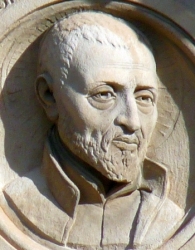
• Joseph Calasanctius
• Joseph of Our Lady
• Joseph Calsanza
Youngest of five children born to Don Pedro Calasanz and Donna Maria Gastonia. His mother and a brother died while he was still in school. Studied at Estadilla, at the University of Lereda, at Valencia, and at Alcala de Henares. Obtained degrees in canon law and theology. His father wanted the Joseph to become a soldier, to marry, and to continue the family, but a near fatal illness in 1582 caused the young man to seriously examine his life, and he realized a call to the religious life.
Ordained on 17 December 1583. Parish priest at Albarracin. Secretary and confessor to his bishop, synodal examiner, and procurator. Revived religious zeal among the laity, discipline among the clergy in a section of the Pyrenees. Both his bishop and his father died in 1587.
Vicar-general of Trempe, Spain. Following a vision, he gave away much of his inheritance, renounced most of the rest, and travelled to Rome, Italy in 1592. Worked in the household of Cardinal Ascanio Colonna as thelogical advisor for the cardinal, tutor to the cardinal's nephew. Worked with plague victims in 1595.
Member of the Confraternity for Christian Doctrine. Tried to get poor children, many of them orphans and/or homeless, into school. The teachers, already poorly paid, refused to work with the new students without a raise; in November 1597, Joseph and two fellow priests opened a small, free school for poor children. Pope Clement VIII, and later Pope Paul V, contributed toward their work. He was soon supervising several teachers and hundreds of students.
In 1602 they moved to larger quarters, and reorganized the teaching priests into a community. In 1612 they moved to the Torres palace to have even more room. In 1621 the community was recognized as a religious order called Le Sciole Pie (Religious Schools), also known as the Piarists, or Scolopii or Ordo Clericorum Regularium Pauperum Matris Dei Scholarum Piarum or Order of Poor Clerks Regular of the Mother of God of the Pious Schools; Joseph acted as superior of the Order.
The community encountered many obstacles - Joseph's friendship with the astronomer Galileo Galilei caused a stir with some Church officials. Some of the ruling class objected that to educate the poor would cause social unrest. Other Orders that worked with the poor were afraid they would be absorbed by the Piarists. But they group continued to have papal support, and continued to do good work.
In his old age, Joseph suffered through seeing his Order torn apart. He was accused of incompetence by Father Mario Sozzi, who was chosen as new superior of the Order. Sozzi died in 1643, and was replaced by Father Cherubini who pursued the same course as Sozzi, and nearly destroyed the Order. A papal commission charged with examining the Order acquitted Joseph of all accusations, and in 1645, returned him to superior of the Order, but internal dissent continued, and in 1646 Pope Innocent X dissolved the Order, placing the priests under control of their local bishops.
The Piarists were reorganized in 1656, eight years after Joseph's death. They were restored as a religious order in 1669, and continue their good work today.
11 September 1556 at Peralta, Barbastro, Aragon, Spain in his father's castle
• 25 August 1648 at Rome, Italy of natural causes
• buried at Saint Panteleone, Rome
16 July 1767 by Pope Clement XIII
• Catholic schools (proclaimed on 13 August 1948 by Pope Pius XII)
• schools, colleges, universities
• students, schoolchildren
• Congregation of Christian Workers of Saint Joseph Calasanz
Piety and Letters - motto of Saint Joseph Calasanz
Everyone knows the great merit and dignity attached to that holy ministry in which young boys, especially the poor, receive instruction for the purpose of attaining eternal life. This ministry is directed to the well-being of body and soul; at the same time, that it shapes behavior it also fosters devotion and Christian doctrine. Moreover the strongest support is provided not only to protect the young from evil, but also to rouse them and attract them more easily and gently to the performance of good works. Like the twigs of plants, the young are easily influenced, as long as someone works to change their souls. But if they are allowed to grow hard, we know well that the possibility of one day bending them diminishes a great deal and is sometimes utterly lost. All who undertake to teach must be endowed with deep love, the greatest of patience, and, most of all, profound humility. They must perform their work with earnest zeal. Then, through their humble prayers, the Lord will find them worthy to become fellow workers with him in the cause of truth. He will console them in the fulfillment of this most noble duty, and finally, will enrich them with the gift of heaven. As Scripture says, "Those who instruct many in justice will shine as stars for all eternity." They will attain this more easily if they make a covenant of perpetual obedience and strive to cling to Christ and please him alone, because, in his words, "What you did to one of the least of my brethren, you did to me." - from the writings of Saint Joseph Calasanz
Lord, You blessed Saint Joseph Calasanz with such charity and patience that he dedicated himself to the formation of Christian youth. As we honor this teacher of wisdom may we follow his example in working for truth. - opening prayer for the Mass for Saint Joseph Calasanz
https://catholicsaints.info/saint-joseph-calasanz/

Louis Capet
Son of King Louis VIII and Blanche of Castile. King of France and Count of Artois at age eleven; his mother ruled as regent until he reached 22, and then he reigned for 44 years. Louis made numerous judicial and legislative reforms, promoted Christianity in France, established religious foundations, aided mendicant orders, propagated synodal decrees of the Church, built leper hospitals, and collected relics. Married Marguerite of Provence at age 19, and was the father of eleven children. Supported Pope Innocent IV in war against Emperor Frederick II of Germany. Trinitarian tertiary. Led two Crusades and died on one.
25 April 1214 at Poissy, France
• 25 August 1270 at Tunis (in modern Tunisia) of natural causes
• relics in the Basilica of Saint Denis, Paris, France
• relics destroyed in 1793 during the French Revolution
1297 by Pope Boniface VIII
• against the death of children
• barbers
• bridegrooms
• builders
• button makers
• construction workers
• Crusaders
• difficult marriages
• distillers
• embroiderers
• French monarchs
• grooms
• haberdashers
• hairdressers
• hair stylists
• kings
• masons
• needle workers
• parenthood
• parents of large families
• passementiers
• prisoners
• sculptors
• sick people
• soldiers
• stone masons
• stonecutters
• tertiaries
• trimming makers
• Québec, Québec, archdiocese of
• Saint Louis, Missouri, archdiocese of
• Versailles, France, diocese of
• Blois, France
• Carthage, Tunisia
• La Rochelle, France
• New Orleans, Louisiana
• Oran, Algeria
• Saint-Louis, Haut-Rhin, France
• Saint Louis, Missouri, city of
• Versailles, France
• Congregation of the Sisters of Saint Louis
• crown
• crown of thorns
• king holding a cross
• king holding a crown of thorns
• nails
In order to avoid discord, never contradict anyone except in case of sin or some danger to a neighbor; and when necessary to contradict others, do it with tact and not with temper. - Saint Louis
In prosperity, give thanks to God with humility and fear lest by pride you abuse God's benefits and so offend him. - Saint Louis IX
My dearest son, my first instruction is that you should love the Lord your God with all your heart and all your strength. Without this there is no salvation. Keep yourself, my son, from everything that you know displeases God, that is to say, from every mortal sin. You should permit yourself to be tormented by every kind of martyrdom before you would allow yourself to commit a mortal sin. If the Lord has permitted you to have some trial, bear it willingly and with gratitude, considering that it has happened for your good and that perhaps you well deserved it. If the Lord bestows upon you any kind of prosperity, thank him humbly and see that you become no worse for it, either though vain pride or anything else, because you ought not to oppose God or offend him in the matter of his gifts. Be kindhearted to the poor, the unfortunate and the afflicted. Give them as much help and consolation as you can. Thank God for all the benefits he has bestowed upon you, that you may be worthy to receive greater. Always side with the poor rather than with the rich, until you are certain of the truth. Be devout and obedient to our mother the Church of Rome and the Supreme Pontiff as your spiritual father. In conclusion, dearest son, I give you every blessing that a loving father can give a sons. May the three Persons of the Holy Trinity and all the saints protect you from every evil. And may the Lord give you the grace to do his will so that he may be served and honored through you, that in the next life we may together come to see him, love him and praise him unceasingly. Amen. - from a spiritual testament by King Saint Louis IX to his son
https://catholicsaints.info/saint-louis-ix/
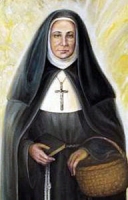
• María Cabanillas
• María del Tránsito Cabanillas
• María del Transito Eugenia de los Dolores Cabanillaswas
• María del Tránsito Of Jesus In The Blessed Sacrament
Third child born to Felipe Cabanillas and Francisca Antonia Luján Sánchez. Raised in a large, wealthy and pious family; she had ten siblings, three of whom died in childhood, one brother became a priest, three sisters nuns. Educated at home and then at Cordoba, Argentina where she studied and helped care for her seminarian younger brother until his ordination in 1853.
Maria's father died in 1850, and the rest of the family moved to Cordoba, living near the church of San Roque. Maria stayed at home, helping her mother with the children, maintaining a personal piety and devotion to the Eucharist, working as a catechist, and visiting the poor and sick of Cordoba. Maria's mother died on 13 April 1858.
With her family grown or gone, Maria now felt free to pursue her religious vocation, and she entered the Franciscan Third Order at age 37, devoting more of her day to prayer. In 1871 she met Mrs Isidora Ponce de León who was building a Carmelite monastery in Buenos Aires, Argentina. In 1872 Maria moved to Buenos Aries, and entered the monastery on 19 March 1873. For health reasons, she was forced to leave the cloister in April 1874. In September 1874 she entered the convent of the Sisters of the Visitation in Montevideo, Uruguay, but had to leave there in a few months due to her continuing health problems.
During this time of turmoil and rejection of her perceived vocation, Maria began again to ponder an idea that had followed her all her life - an education and assistance foundation to help children. Several Franciscans encouraged her, and Father Agustin Garzón offered her a house and his help and contacts. She obtained approval for the project on 8 December 1878, and with her companions Teresa Fronteras and Brigida Moyano, and Bother Cirlaco Porreca as director, she started the Congregation of the Franciscan Tertiary Missionaries of Argentina, dedicated to helping the poor, orphaned and abandoned. The three women made their religious profession on 2 February 1879, and their institute became offically affiliated with the Franciscans on 28 January 1880.
The new Congregation met with immediate success in vocations - the Argentinian colleges of Saint Margarite of Cortona in San Vicente, El Carmen in Rio Cuarto, and Immaculate Conception in Villa Nueva were founded during Maria's lifetime. The work, however, ruined her already frail health, and she died within six years.
15 August 1821 on the estate of Santa Leocadia, now Carlos Paz, Cordoba, Argentina as Maria Cabanillas
25 August 1885 at San Vicente, Cordoba, Argentina of natural causes
14 April 2002 by Pope John Paul II
"Did not our hearts burn within us while he talked to us on the road, while he opened to us the Scriptures?" (Luke 24:32). This surprising confession of the disciples who first walked to Emmaus is what happened with the vocation of Mother María del Tránsito Cabanillas de Jesús Sacramentado, foundress of the Third Order Franciscan Missionaries and the first Argentinian woman to be beatified. The flame that burned in her heart brought María del Tránsito to seek intimacy with Christ in the contemplative life. She was not deterred when on account of bad health she had to abandon the monasteries where she was living, but continued with a confidence and abandonment to the divine will which she followed on her constant quest. The Franciscan ideal then appeared as the true way that God wanted for her and, aided by wise directors, she undertook a life of poverty, humility, patience and charity, giving rise to a new religious family. – from the beatification homily by Pope John Paul II
https://catholicsaints.info/blessed-maria-del-transito-de-jesus-sacramentado/

• Ebbe of Coldingham
• Abbs, Aebbe, Ebba, Tabbs
Daughter of the pagan King Aethelfrith the Ravager of Bernicia and Princess Aacha of Deira, one of seven children. Sister of Saint Oswald of Northumbria and King Oswiu. Niece of Saint Ethelreda. When her father was killed in battle when Ebbe was about ten years old, her mother fled with the family for the court of King Eochaid Buide at Dunadd in modern Scotland. There she converted to Christianity.
A Scottish prince, Aidan, wished to marry Ebbe, and the family was in favour, but Ebbe was drawn to the religious life. Benedictine nun at the double monastery at Coldingham c.655, taking the veil from Saint Finan of Iona. Aidan, determined to marry her, followed, planning to carry her off. She fled to a high rock. The tide came in, cutting her off from the land and her pursuer. Because of her prayers, the tide remained high for three days, holding off Aidan until he realized the divine nature of her protection, and gave up.
Founded the monastery of Ebchester (i.e., Ebbe's castle or Ebbe's camp) on an old Roman camp on the River Dawent, in County Durham, land given her by her brother Oswiu. Later, during one of the disruptions in the kingdom, Aebbe was captured, but escaped, fleeing in a small boat down the River Humber and out to sea. A supernatural being then sailed the craft safely through dangerous seas till it landed on a spit of land in Berwickshire, defended on three sides by the sea, and on the forth by swampy land. A group of monks, singing in a church that was later renamed for Ebbe, witnessed this, and became some of the first brothers at the large double monastery she founded there. Abbess.
Friend of Saint Cuthbert of Lindisfarne, who normally avoided women but came to visit Ebbe. Saint Ethelreda stayed at her monastery as a nun in 672. Peacemaker among the local laity. Though she was noted for her own piety, Ebbe had trouble enforcing discipline at the monastery. The monks and nuns became very lax and worldly. One of the brothers, Adomnan, received a vision prophesying that the monastery would burn to the ground; it did, not long after Ebbe's death.
c.615 in Northumbria, England
25 August 683 at Coldingham, Berwickshire, Scotland of natural causes
https://catholicsaints.info/saint-ebbe-the-elder/
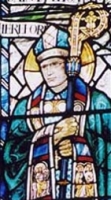
• Thomas de Cantilupe
• Thomas de Cantelow
• Thomas de Cantelou
• Thomas de Canteloupe
• Thomas de Cantelupo
• 25 August (Roman Martyrology)
• 3 October (in England)
Born to the nobility, the son of Baron William de Cantilupe. Educated in Oxford, England, and in France at Paris and Orléans. Priest. Attended the Council of Lyons in 1245. Papal chaplain. Taught canon law at the University of Oxford, and was chosen the university chancellor in 1262. Diplomat to Saint Louis of France in 1264 during the Barons' War. Appointed Lord Chancellor of England on 25 February 1265. Attended the Second Council of Lyons in 1274. Bishop of Hereford, England, appointed on 14 June 1275 and consecrated on 8 September 1275. Known for his large charity to the poor and his blameless personal life, endlessly involved in both Church and civil matters. Advisor to King Edward I.
Following a series of disputes between Thomas and Archbishop John Peckham of Canterbury, Peckham excommunicated Thomas. Thomas travelled to Rome, Italy to put his case before Pope Martin IV, was absolved of wrong-doing, and died in full communion with the Church while on his way back to England.
c.1218 in Hambledon, Buckinghamshire, England
• 25 August 1282 in Ferento, Montefiascone, Italy of natural causes
• buried in Hereford Cathedral
• his skull was moved to a reliquary at Downside Abbey, Somerset, England in 1881
17 April 1320 by Pope John XXII
bishop with Hereford Cathedral
https://catholicsaints.info/saint-thomas-of-hereford/

Gelasinus, Gelasius
Genesius was an actor who worked in a series of plays that mocked Christianity. One day while performing in a work that made fun of Baptism he received sudden wisdom from God, realized the truth of Christianity, and had a conversion experience on stage. He announced his new faith, and refused to renounce it, even when ordered to do so by emperor Diocletian. Martyr.
beheaded c.303 at Rome, Italy
• actors
• against epilepsy, epileptics
• attorneys, barristers, lawyers
• clowns
• comedians, comediennes, comics
• converts
• dancers
• musicians
• printers
• stenographers
• torture victims
• medals and pendants, page 1
• medals and pendants, page 2
• medals and pendants, page 3
https://catholicsaints.info/saint-genesius-of-rome/
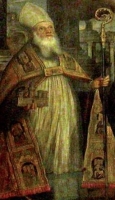
• Genesius of Brixellum
• Genesio...
Bishop of Brescello, Italy, possibly the first in this diocese.
latter 4th century
• early 5th century in Brescello, Provincia di Reggio Emilia, Emilia-Romagna, Italy
• relics re-discovered in the walls of an old church during construction of a castle on the land in 968
• a church and monastery in his honour was built on the land, and the relics enshrined in the main altar of the abbey church
• his arm bone was enshrined in a gilded copper sleeve-shaped reliquary in 1408
• relics re-enshrined in the wall of the church of San Mauro which was later renamed the church of Saint Mauro and Genesio
• relics re-enshrined in a silver reliquary in the shape of an arm giving a blessing in 1746
• relics transferred to the Chapel of the Most Blessed Sacrament in the parish Church of Santa Maria Nascente in Brescello in 1797 when the monastic property was seized by the Cisalpine Republic
• relics moved to the nearby Church of the Immaculate Conception in 1830 when the original church was under re-construction
• relics re-enshrined in a gold reliquary in the Chapel of the Most Blessed Sacrament in the parish Church of Santa Maria Nascente in Brescello
Brescello, Italy
https://catholicsaints.info/saint-genesius-of-brescello/
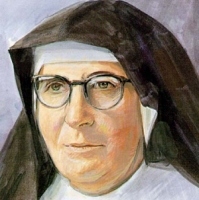
Worked as a Red Cross nurse in an Italian military hospital during World War I. Nun in the Salesian Sisters. In 1922 she left Italy for Ecuador and spent the rest of her life working with the Shuar tribe in the Amazon forest.
16 February 1883 in Corteno Golgi, Brescia, Italy
25 August 1969 in a plane crash in Sucúa, Morona-Santiago, Ecuador
• 24 November 2012 by Pope Benedict XVI
• beatification recognition was celebrated at Macas, Morona Santiago, Ecuador, presided by Cardinal Angelo Amato
You tell me that you are always hoping to see me return to Italy. At my age it is impossible and not the fault of my Superiors. They have told me many times that they would let me come to see my family if I wanted to. I never accepted first because my place is here, but also because, when the day to leave arrived, the detachment from my parents, Superiors, country, language, from everything cost me dearly. When I boarded the boat, I said goodbye forever. We will see each other once again in Heaven. - Blessed Maria on the eve of her 85th birthday writing to family in Italy
https://catholicsaints.info/blessed-maria-troncatti/
Michael Carvalho
Entered the Jesuits in 1597. Missionary to Goa, India. Priest. Taught theology for 15 years. Missionary to Japan. Arrested in July 1863 for spreading Christianity, he spent several months in prison before being killed. Martyr.
1579 in Braga, Portugal
roasted alive on 25 August 1624 in Omura, Nagasaki, Japan
7 May 1867 by Pope Blessed Pius IX
I should feel the greatest sorrow if Our Lord, on account of my sins, should withdraw me from the path of mercy and grace now open before me. I am always a prey to the fear lest the Lord should desire to punish me and deprive me of the supreme blessing, of which His divine goodness no longer considers me deserving. Nothing in this life appears to me more desirable, more delightful, and more consoling than to give my life for so merciful a Saviour. - Blessed Miguel, commenting on his sentence to martyrdom
https://catholicsaints.info/blessed-miguel-carvalho/
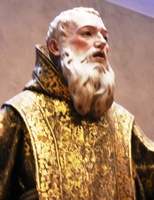
• Ginés de la Xara
• Ginés el Franco
• Genesius Sciarensis
A holy man, and probably a hermit, who lived in the area of modern Cartagena, Spain early in the faith. We know almost nothing about him for sure, but many, many stories and legends have been attached to him, and he has been confused with Saint Genesius of Arles, Saint Genesius of Brescello and/or Saint Genesius of Rome who are remembered on the same day.
1541 by Pope Paul III
• against hernias
• against storms
• agricultural laborers
• sailors
• vintners
• Cartagena, Spain
https://catholicsaints.info/saint-gines-de-la-jara/
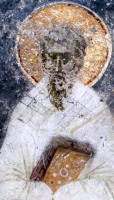
Mennas, Mina, Minas
Superior of the hospice of Saint Samson in Constantinople. Patriarch of Constantinople, ordained and consecrated by Pope Saint Agapetus in 536 to replace Anthimus who had fallen into the monophysite heresy. Led the synod of Constantinople in 536. Consecrated the church of Hagia Sophia. Subscribed to the Edict of the Emperor Justinian condemning the documents known as the “Three Chapters” for which he was excommunicated by Pope Vigilius in 551; he immediately submitted to papal authority.
Alexandria, Egypt
August 552 in Constantinople (modern Istanbul, Turkey) of natural causes
https://catholicsaints.info/saint-menas-of-constantinople/
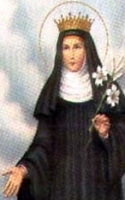
• Patricia of Constantinople
• Patrizia of....
Born to the nobility, possibly related to the emperor. To escape an arranged marriage, and to give herself to the religious life, she made a pilgrimage to Jerusalem and then to Rome, Italy. Nun in Rome. Returned to Constantinople to give away her wealth to the poor. She then returned to Naples, Italy to make pilgrimages to the tombs of martyrs and saints.
at Constantinople (modern Istanbul, Turkey)
• c.665 at Naples, Italy of natural causes
• a vial of her blood reportedly liquifies periodically
Naples, Italy
https://catholicsaints.info/saint-patricia-of-naples/
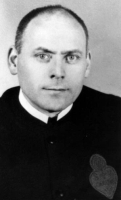
Fratel Luigi of the Consolata
Drafted into the Italian army, he fought in World War II, was captured by the Soviets, and imprisoned in Siberia. Released after the war, he joined the Brothers of Saint Joseph Benedict Cottolengo, taking the name Luigi of the Consolata and working for 30 years with the sick and the mentally ill.
12 August 1922 in Castellinaldo, Alba, Italy
25 August 1977 in Turin, Italy of natural causes
• 2 May 2015 by Pope Francis
• beatification recognition celebrated at Turin, Italy, Cardinal Angelo Amato, presiding
https://catholicsaints.info/blessed-andrea-bordino/
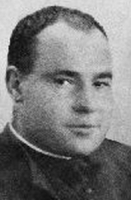
Priest. Member of the Sons of the Holy Family. Secretary of his community and science teacher at Saint Peter the Apostle school in Reus, Tarragona, Spain. He was arrested on 25 July 1936 during the persecutions of the Spanish Civil War for the crime of being a priest, imprisoned on the ship Cabo Cullera of Tarragona, and then executed. Martyr.
7 December 1889 in Torelló, Barcelona, Spain
• 25 August 1936 in Vila-rodona, Tarragona, Spain
• buried in the cemetery of Vila-rodana
13 October 2013 by Pope Francis
https://catholicsaints.info/blessed-francesc-llach-candell/
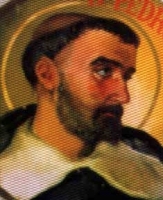
Father Pedro of Saint Catherine
10 September as one of the 205 Martyrs of Japan
Dominican, assigned to Madrid, Spain, then Manila in the Philippines. Priest. Missionary to Japan. Arrested on 18 April 1623 for the crime of moving the body of the martyred Blessed Ludovico Flores, he spent 16 months of abuse in prison before being executed for remaining a Christian. Martyr.
1590 in Verín, Orense, Spain
burned alive on 25 August 1624 in Omura, Nagasaki, Japan
7 May 1867 by Pope Blessed Pius IX
https://catholicsaints.info/blessed-pedro-vazquez/
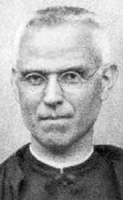
Priest. Member of the Sons of the Holy Family, and the treasurer of his community. Teacher at Saint Peter the Apostle school in Reus, Tarragona, Spain. He was arrested on 27 July 1936 during the persecutions of the Spanish Civil War for the crime of being a priest, imprisoned on the ship Rio Segre of Tarragona, and then executed. Martyr.
3 November 1879 in Margalef, Tarragona, Spain
• about 10am on 25 August 1936 in Vila-rodona, Tarragona, Spain
• buried in the cemetery of Vila-rodona
13 October 2013 by Pope Francis
https://catholicsaints.info/blessed-fermi-martorell-vies/
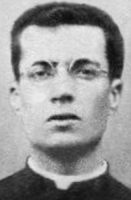
Raised in a pious family; three of his brothers entered religious life. Had a devotion to Saint John Berchmans. Priest. Member of the Sons of the Holy Family. Director of the Saint Peter the Apostle school in Reus, Spain. Supporter, spiritual and material, of vocations in others. Ministered to prisoners in Reus and on the prison ships of Tarragona, Spain. Martyred in the Spanish Civil War.
31 December 1908 in Bellmunt, Tarragona, Spain
25 August 1936 in Vila-rodona, Tarragona, Spain
13 October 2013 by Pope Francis
https://catholicsaints.info/blessed-eduard-cabanach-majem/
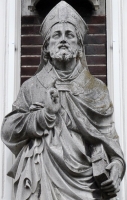
Gregory of Pfalzel
Son of Saint Wastrada, and uncle of Saint Alberic of Utrecht. Spiritual student and Benedictine monk under Saint Boniface whom he had met as a child, and who acted as a mentor. Abbot of Saint Martin's abbey, Utrecht, Netherlands, during which it became a centre for missionaries and the home of many saints. Bishop of Utrecht for 22 years.
703 at Trier, Germany
• 776 of natural causes
• buried at Susteren Abbey
abbot giving alms to the poor
https://catholicsaints.info/saint-gregory-of-utrecht/
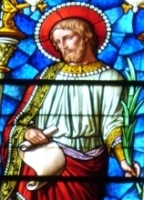
Soldier. Literate, he was made a notary and secretary to the magistrate of Arles, France. Convert. During the period of his catechumenate, Maximianus issued his decree of persecution against Christians. Outraged, Genesius threw his writing tablets at the feet of his magistrate, denounced the orders, was imprisoned, and executed. Martyr.
at Arles, France
c.305
• against chilblains
• against scurf
• notaries
• secretaries
https://catholicsaints.info/saint-genesius-of-arles/
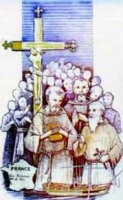
Trappist monk. Priest. Imprisoned on a ship in the harbor of Rochefort, France and left to die during the anti-Catholic persecutions of the French Revolution. One of the Martyrs of the Hulks of Rochefort.
29 September 1743 in Millery, Côte-d'Or, France
25 August 1794 aboard the prison ship Deux-Associés, in Rochefort, Charente-Maritime, France
1 October 1995 by Pope John Paul II
https://catholicsaints.info/blessed-paul-jean-charles/
Hunegund was drawn to religious life, but was compelled to marry against her wishes. She convinced her future husband to accompany her on a pilgrimage to Rome, Italy, and then got him to agree that she should become a Benedictine nun, receiving the veil from Pope Saint Vitalian. When they returned home, Hunegund entered the convent at Homblieres in northern France ;her ex-future husband became a priest, and served as chaplain to the convent.
c.690
https://catholicsaints.info/saint-hunegund-of-homblieres/
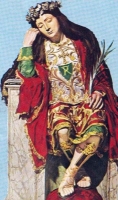
Pellegrino
Martyred in the persecutions of Emperor Commodus.
• stretched on the rack, beaten with clubs, burned, then beaten to death with lead-tipped whips in 192 at Rome, Italy
• buried in the catacombs in Rome
• Pope Saint Nicholas I sent his relics to Vienne, France in 863
https://catholicsaints.info/saint-peregrinus-of-rome/
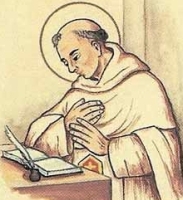
Friend of Saint Peter Nolasco, who urged him to join the Mercedarians; Peter did at the convent of Sant Antonio Abate in Tarragona, Spain. Dispatched to Africa in 1236 to ransom a large number of Christians who had been enslaved by Muslims.
1240 in Tarragona, Spain of natural causes
https://catholicsaints.info/blessed-pedro-de-calidis/
17 November (Greek Menae)
Priest, bishop and Patriarch of Constantinople from 458 to 471. Known for his learning, his biblical scholarship, and as a great speaker. Fought heresies of the period, and simony. Legend says he would not ordain a new priest until the candidate could recite the Psalms by heart.
https://catholicsaints.info/saint-gennadius-of-constantinople/
10 September as one of the 205 Martyrs of Japan
Member of the Franciscan Friars Minor (Observants). Priest. Martyr.
6 September 1574 in Seville, Spain
burned alive on 25 August 1624 in Omura, Nagasaki, Japan
7 May 1867 by Pope Blessed Pius IX
https://catholicsaints.info/blessed-luis-cabrera-sotelo/
10 September as one of the 205 Martyrs of Japan
Lifelong layman in the archdiocese of Nagasaki, Japan. Member of the Secular Franciscans. Catechist. Martyr.
Japan
burned alive on 25 August 1624 in Omura, Nagasaki, Japan
7 May 1867 by Pope Blessed Pius IX
https://catholicsaints.info/blessed-ludovicus-baba/
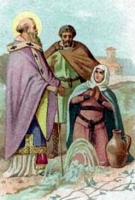
Aredio, Yrieix, Yriez
Founded the monastery of Atane in Limousin, France. The village of Saint Yrieux grew up around the monastery, and was named for the founder.
Limoges, France
25 August 591 at Attane, Limoges, France
https://catholicsaints.info/saint-aredius/
Martyred in the persecution of Emperor Commodus.
• stretched on the rack, beaten with clubs, burned, then beaten to death with lead-tipped whips in 192 at Rome, Italy
• buried in the catacombs in Rome
• relics translated to Vienne, France, in 863 by Pope Saint Nicholas I
https://catholicsaints.info/saint-eusebius-of-rome-25-august/
10 September as one of the 205 Martyrs of Japan
Member of the Franciscan Friars Minor (Observants). Priest. Martyr.
Tokyo, Japan
burned alive on 25 August 1624 in Omura, Nagasaki, Japan
7 May 1867 by Pope Blessed Pius IX
https://catholicsaints.info/blessed-ludovicus-sasada/
Martyred in the persecutions of Emperor Commodus.
• stretched on the rack, beaten with clubs, burned, then beaten to death with lead-tipped whips in 192 at Rome, Italy
• buried in the catacombs in Rome
• Pope Saint Nicholas I sent his relics to Vienne, France in 863
https://catholicsaints.info/saint-pontian-of-rome-25-august/
Martyred in the persecutions of Emperor Commodus.
• stretched on the rack, beaten with clubs, burned, then beaten to death with lead-tipped whips in 192 at Rome, Italy
• buried in the catacombs in Rome
• Pope Saint Nicholas I sent his relics to Vienne, France in 863
https://catholicsaints.info/saint-vincent-of-rome-25-august/
Nemesio
Father of Saint Lucilla. Roman military tribune. Convert, brought to Christianity by Pope Saint Stephen I. Deacon in Rome, Italy. Martyred in the persecutions of Valerian.
Roman citizen
beheaded with a sword c.260 in Rome, Italy
https://catholicsaints.info/saint-nemesius-of-rome/
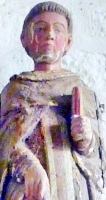
Benedictine monk. Prior of Redon Abbey. Abbot of Sainte-Croix of Quimperle, Brittany (in modern France).
1057 in Brittany, France of natural causes
https://catholicsaints.info/saint-gurloes-of-sainte-croix/

Magí
Evangelized in the area of Tarragona, Spain. Martyred in the persecutions of Diocletian.
Tarragona, Spain
beheaded c.304 near Tarragona, Spain
https://catholicsaints.info/saint-maginus/
First century missionary to Spain; legend says he was a spiritual student of the Apostles. Bishop of Talco (Italica), Spain. Martyr.
c.100 in prison
https://catholicsaints.info/saint-geruntius-of-italica/
Founded the monastery of Saint Eusebius in Apt, France.
Saignon, France
485
https://catholicsaints.info/saint-marcian-of-saignon/
Monk. Founded a monastery in Agde, Gaul (in modern France), and served as its first abbot.
https://catholicsaints.info/saint-severus-of-agde/
Priest.
Syrian
https://catholicsaints.info/saint-julian-of-syria-25-august/
Ermete
Martyr.
https://catholicsaints.info/saint-hermes-of-eretum/
Giulio
Martyr.
https://catholicsaints.info/saint-julius-of-eretum/
Thousands of people were murdered in the anti-Catholic persecutions of the Spanish Civil War from 1934 to 1939. I have pages on each of them, but in most cases I have only found very minimal information. They are available on the CatholicSaints.Info site through these links:
• Blessed Antoni Prenafeta Soler
• Blessed Antoni Vilamassana Carulla
• Blessed Enric Salvá Ministral
• Blessed Florencio Alonso Ruiz
• Blessed Fortunato Merino Vegas
• Blessed Josep Maria Panadés Terré
• Blessed Juan Pérez Rodríguez
• Blessed Luis Gutiérrez Calvo
• Blessed Luis Urbano Lanaspa
• Blessed Manuel Fernández Ferro
• Blessed Miguel Grau Antolí
• Blessed Pere Farrés Valls
• Blessed Ramon Cabanach Majem
• Blessed Salvi Tolosa Alsina
• Blessed Vicente álvarez Cienfuegos
CatholicSaints.Info Portable Edition